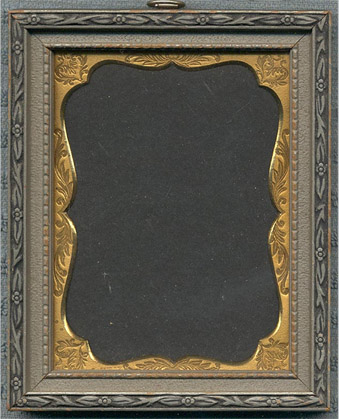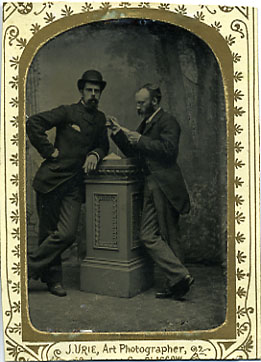
URIE DAGUERREOTYPE FRAME
Urie (b 1820, d. 1910) states in his published reminiscences that his interest in photography was aroused during a visit to the 1851 exhibition in London where he saw the daguerreotype process. At that time he was carving wooden type blocks for printing, but made his own camera and started experimenting. He built a 'glasshouse' studio on top of the building at 33 Buchanan street, and soon had more sitters than he could cope with.

He speaks in his memoirs of the need in the early days to 'dissolve half crowns in acid' to obtain silver nitrate and even 'dissolve sovereigns in acids' to obtain a gold toning bath. One notable incident in his long career occurred when he photographed a family named Smith, the daughter being a certain Madeleine, who soon after was arrested for murder. He enlarged her picture, and placed it in his window, and such was the public interest that police had to be called to control the crowds.
The image below is of a ferrotype ('tintype') pasted behind a printed card frame. It was originally larger, but has been crudely trimmed to roughly cdv size (6 x 8.5 cms). The smaller image is much as it appears, not so much a 'black and white' but 'gray and black', but the enlargement has been enhanced. This example is likely to date to the late 1850s or early 1860s.

The chronological sequence of the four cdvs below is not certain. The first, which has only a handwritten 'Grandfather Mitchell' on the back, might be presumed to be the earliest, perhaps 1862 or 1863. The first three share the same card size ( 6.4 x 10.2cms) and thickness (0.021"), while the fourth is closer in size to the cdv 'standard' - 6.3 x 10.6 cms, but is thinner at 0.018". The second and fourth cards however seem to have the same backdrop. The third is on a higher quality card material. There are indications that none are later than the mid 1860s. The stand of a neck brace can just be seen behind the feet of the gentlemen, showing that the exposure time was still several seconds. The second gent's sideburns, tall bowler, and non-matching jacket and trousers, and the ladies' hair style, with partially covered ears, are characteristic of the early 1860s.